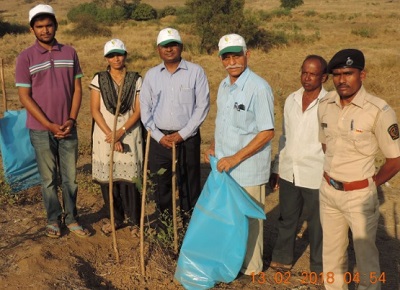About SVT
In recent past hillslopes and fallow lands across various regions are increasingly susceptible to uncontrolled wildfires. These fires result in massive ecological and economic losses, including the destruction of biomass, disruption of soil biodiversity, and increased risk of landslides. The loss of vegetation cover further exacerbates soil erosion, leading to rock outcroppings and reduced water infiltration, which hinder the recharging of local aquifers. The cumulative effect of these factors is a significant degradation of the ecosystem, impacting both wildlife and human livelihood.
Recognizing the urgent need for a sustainable solution, Shri Chandrashekhar Bhadsavle, a visionary with a background in Food & agricultural Sciences, returned to India from the USA in 1976. Inspired by his father's dream of enriching rural India, he embarked on a journey that led to the innovation of the Saguna Vansanvardhan Technique (SVT). This technique, along with other initiatives like Saguna Regenerative Technique (SRT) and Krishi Paryatan, has gradually evolved. SVT, in particular, was conceptualized in 2014 at Saguna Baug, Neral, Raigad, and has since demonstrated remarkable success in preventing forest fires and regenerating greenery on barren hills.
Wildfires in the said areas are caused because the end of the rainy season leaves behind dry, flammable vegetation, which is a primary fuel for wildfires. The technique involves the strategic use of systemic general-purpose weedicide to prevent this dry vegetation from becoming a fire hazard. Additionally, the SVT-Sleeve, a three-layer plastic cover, is used to protect young saplings, enhancing their survival rate and contributing to the reforestation of barren lands. The technique also incorporates the planting of specific species like Karonda, Wild Cliff Bananas, and Vetiver grass, known for their resilience and ability to stabilize soil and conserve water.
The implementation of SVT has led to significant environmental benefits, including the prevention of soil erosion, enhancement of biodiversity, and increased carbon sequestration, which is crucial in the fight against global warming. The technique has been recognized with a state award, underscoring its effectiveness and potential for broader application. The success of SVT is not only a testament to innovative environmental stewardship but also aligns with multiple Sustainable Development Goals, contributing to a more sustainable and resilient future. Now, it is time to scale this technology to all over Maharashtra through the forest department.
The Saguna Vanasanvardhan Technique (SVT), pioneered by the SVT Team at Saguna Baug, Neral, Raigad is nothing but a simple and effective technique to stop forest fires and to reproduce green perennial vegetation. Preventing forest fires and thus, restoring the natural vegetation, ultimately enhancing the water infiltration and aquifer recharging capacities is the basic tenant on which the SVT project is built upon. SVT has been operational after the in-principal oral approval by Principal Secretary, Mr. Vikas Kharge, Forest Department, Govt. of Maharashtra, since 2018, for implementation of the pilot project on 3 hills at Neral.

Principal Secretary Mr. Vikas Kharge, Forest Department, Govt. of Maharashtra, appreciating the innovative Saguna Vansanvardhan Technique (SVT) February 2018, at the demonstration site. This groundbreaking method, developed by our dedicated team, marks a significant step forward in forest fire prevention and sustainable forest management.
Successful implementation of SVT projects on hills is essentially achieving the Sustainable Development Goal number 6, ensuring mitigation to the impending water crisis before the nation, and ultimately the world.
Positive results have been observed and recorded on all the project sites where SVT has been implemented and have been applauded by noteworthy scientists such as Dr. Murli Gopal, Soil Microbiologist, CPCRI, Kerala; Dr. Emmanuel deSilva, WB; Dr. Afroz Ahemad, Chairman, Narmada Rehabilitation Centre; Chief Justice (Ex) Shri Ambadas Joshi, Mr. Milind Mhaiskar (Forest) & Mrs. Manisha Mhaiskar (Environment), to name a few.
The Saguna Vansanvardhan Technique (SVT) represents a pioneering approach in the realm of environmental conservation, specifically targeting the prevention of wildfires and the regeneration of greenery on barren hills and fallow lands. SVT has emerged as a practical, innovative solution to some of the most pressing ecological challenges of our time.
SVT is designed with multiple objectives, each addressing a critical aspect of environmental degradation:
- Prevention of Uncontrolled Wildfires: By managing dry vegetation that fuels forest fires, SVT aims to significantly reduce the occurrence of these destructive events.
- Soil Erosion Control and Regeneration: The technique focuses on stopping soil erosion on hill slopes and initiating the regeneration of new soil, thereby enhancing the health of the land.
- Water Conservation: Through soil aggregation, SVT transforms hills into large reservoirs of water, improving the local water table and aiding in drought mitigation.
- Biodiversity Enhancement: By creating live contour bunding using specific plant species, SVT promotes the survival of new tree species and contributes to the restoration of ecological balance.
- Landslide Prevention: The stabilization of hill slopes through vegetation and soil management significantly reduces the risk of landslides.
- Safety of Forest Workers: By reducing the frequency and intensity of forest fires, SVT also aims to minimize the risks faced by forest workers during firefighting efforts.